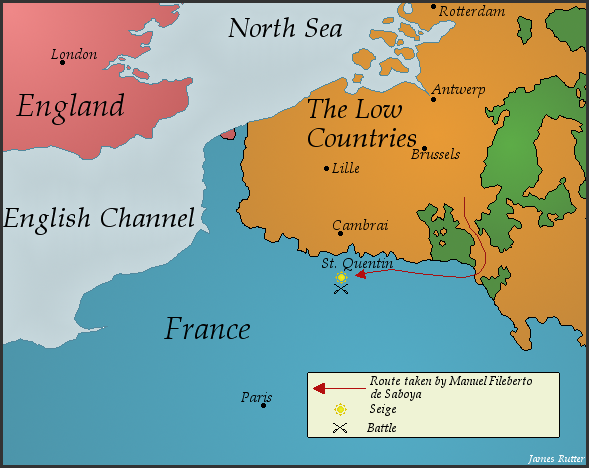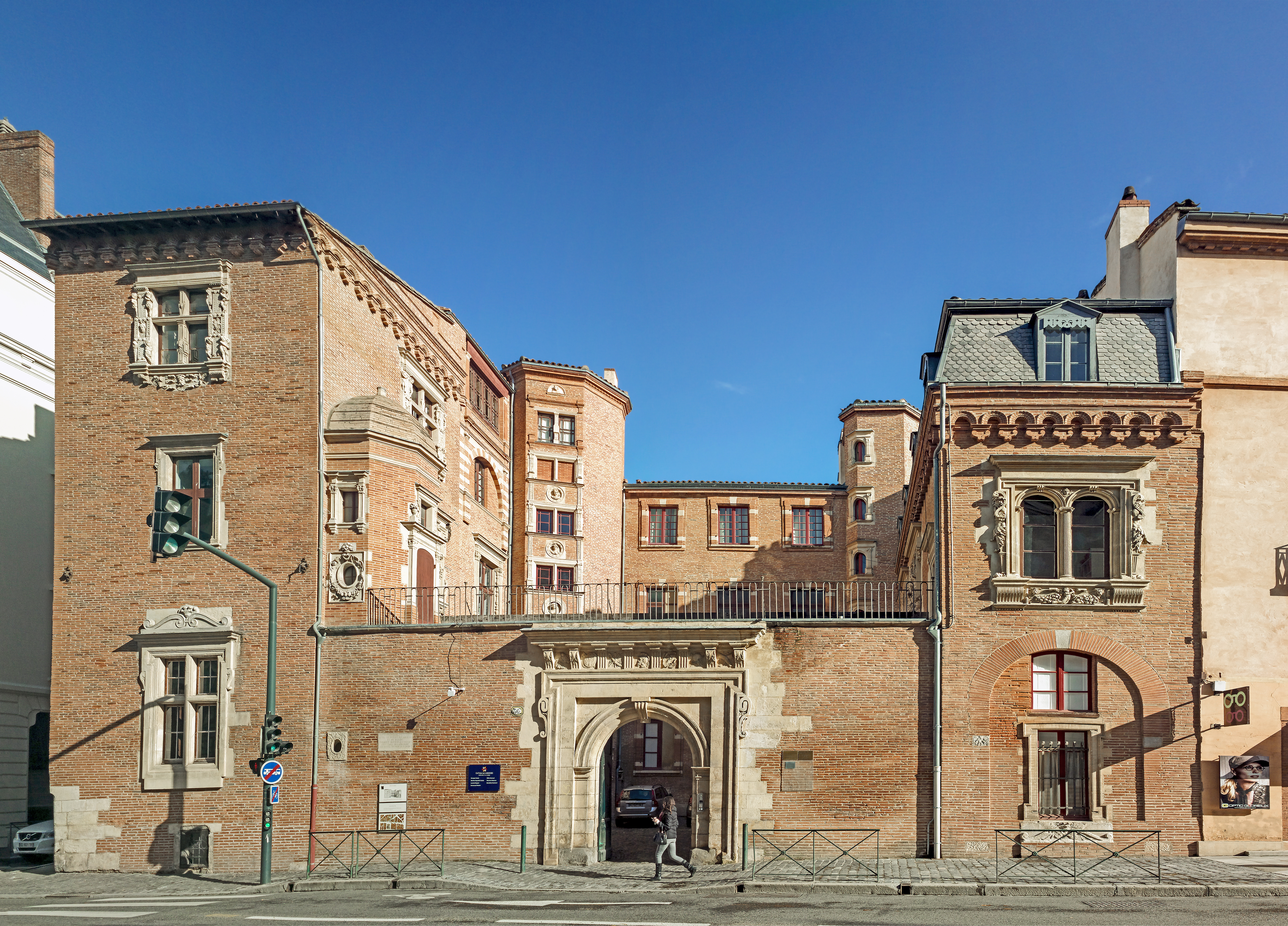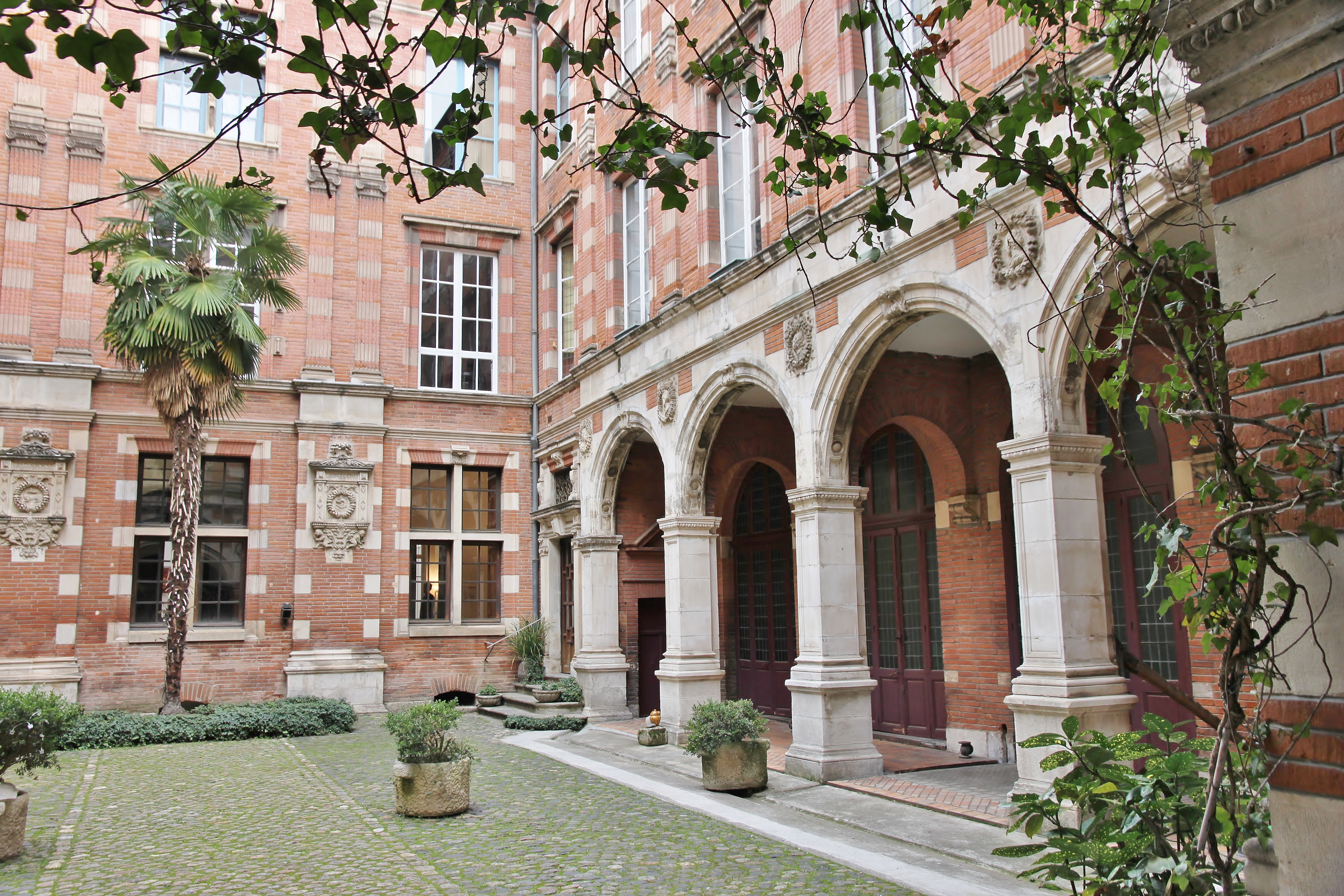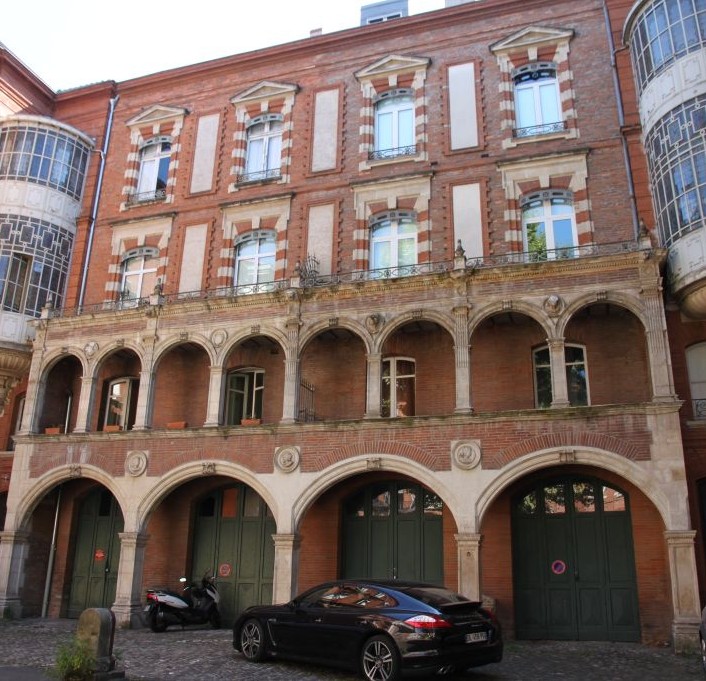|
Nicolas Bachelier
Nicolas Bachelier (1485–1557) was a French surveyor, architect, and sculptor who particularly worked in Toulouse. Bachelier is famous in Toulouse for having been the architect, proven or presumed, of several '' hôtels particuliers'' of the Renaissance, as well as for his religious sculptures. He was particularly renowned for his great scholarly culture. In 1539, Bachelier and his colleague Arnaud Casanove, who described themselves as ''expert levelers'', proposed a survey for a canal from Toulouse to Carcassonne to Francis I. Francis I had previously discussed the possibility of such a canal with Leonardo da Vinci. They also proposed that barges could either float down the Garonne River to Bordeaux or could traverse a canal parallel to the river. Francis I approved their plans which included a lock-free canal of variable depth. These plans proved to be inaccurate and could not be executed. In 1598, Henri IV re-examined the plans, but nothing was done until Pierre Paul R ... [...More Info...] [...Related Items...] OR: [Wikipedia] [Google] [Baidu] |
Toulouse
Toulouse ( , ; oc, Tolosa ) is the prefecture of the French department of Haute-Garonne and of the larger region of Occitania. The city is on the banks of the River Garonne, from the Mediterranean Sea, from the Atlantic Ocean and from Paris. It is the fourth-largest city in France after Paris, Marseille and Lyon, with 493,465 inhabitants within its municipal boundaries (2019 census); its metropolitan area has a population of 1,454,158 inhabitants (2019 census). Toulouse is the central city of one of the 20 French Métropoles, with one of the three strongest demographic growth (2013-2019). Toulouse is the centre of the European aerospace industry, with the headquarters of Airbus, the SPOT satellite system, ATR and the Aerospace Valley. It hosts the CNES's Toulouse Space Centre (CST) which is the largest national space centre in Europe, but also, on the military side, the newly created NATO space centre of excellence and the French Space Command and Space Academy. Thales ... [...More Info...] [...Related Items...] OR: [Wikipedia] [Google] [Baidu] |
Hôtel De Bagis
The Hôtel de Bagis in Toulouse, France, is a Renaissance ''hôtel particulier'' (''palace'') of the 16th century. It is a listed historical monument since 1889. Hôtel de Pierre, dit aussi hôtel Jean de Bagis It is also called Hôtel de Clary, after the owner who carried out the second campaign of works at the beginning of the 17th century, or Hôtel de pierre (meaning «stone hotel») because of its spectacular stone façade on the street. History The Hotel de Bagis is a mansion located at 25 rue de la Dalbade, in the historic center of Toulouse. The Toulouse people call it the Hôtel de Pierre (stone mansion), because its façade is entirely made of stone, which was unique in Toulouse in the 17th century. It is an exceptional ensemble of the Renaissance of Toulouse. The construction of a first hotel begins in 1537 under the direction of the famous Toulouse architect Nicolas Bachelier. The hotel was modified in 1611 by the architect Pierre Souffron, who built the new façade o ... [...More Info...] [...Related Items...] OR: [Wikipedia] [Google] [Baidu] |
People From Arras
A person ( : people) is a being that has certain capacities or attributes such as reason, morality, consciousness or self-consciousness, and being a part of a culturally established form of social relations such as kinship, ownership of property, or legal responsibility. The defining features of personhood and, consequently, what makes a person count as a person, differ widely among cultures and contexts. In addition to the question of personhood, of what makes a being count as a person to begin with, there are further questions about personal identity and self: both about what makes any particular person that particular person instead of another, and about what makes a person at one time the same person as they were or will be at another time despite any intervening changes. The plural form "people" is often used to refer to an entire nation or ethnic group (as in "a people"), and this was the original meaning of the word; it subsequently acquired its use as a plural form of per ... [...More Info...] [...Related Items...] OR: [Wikipedia] [Google] [Baidu] |
1557 Deaths
__NOTOC__ Year 1557 ( MDLVII) was a common year starting on Friday (link will display the full calendar) of the Julian calendar. Events January–June * March – The Takeda clan besiege Katsurayama Castle in eastern Japan. The siege ends with the last stand of the castle garrison, and the complete destruction of Katsurayama, allowing the Takeda to further expand in Shinano Province. * April 12 – The Spanish settlement of Cuenca, Ecuador, is founded. * April 30 – Arauco War – Battle of Mataquito: Spanish forces of Governor Francisco de Villagra launch a dawn surprise attack against the Mapuche (headed by their toqui Lautaro), in present-day Chile. * By June – The 1557 influenza pandemic has spread, probably from China, to Europe. * June 7 – Mary I of England joins her husband Philip II of Spain, in his war against France. * June 10 – The New Testament of the Geneva Bible, a Protestant Bible translation into English (produced ... [...More Info...] [...Related Items...] OR: [Wikipedia] [Google] [Baidu] |
1485 Births
Year 1485 ( MCDLXXXV) was a common year starting on Saturday (link will display the full calendar) of the Julian calendar. Events January–December * Spring – Multiple earthquakes occur near Taishan, China. * March 16 – A solar eclipse crosses northern South America and Central Europe. * June 1 – Matthias of Hungary takes Vienna, in his conquest of Austria (from Frederick III), and makes the city his capital. * August 5–August 7 – The first outbreak of sweating sickness in England begins. * August 22 – Battle of Bosworth: King Richard III of England is defeated by (rival claimant to the throne of England) Henry Tudor, Earl of Richmond; Richard dies in battle, and Henry Tudor becomes King Henry VII of England (although Henry marks this battle as August 21, so that he can declare all his opponents traitors). * September 12 – Muscovian forces conquer Tver. * September 15 – Peter Arbues is assaulted while praying in the ca ... [...More Info...] [...Related Items...] OR: [Wikipedia] [Google] [Baidu] |
French Surveyors
French (french: français(e), link=no) may refer to: * Something of, from, or related to France ** French language, which originated in France, and its various dialects and accents ** French people, a nation and ethnic group identified with France ** French cuisine, cooking traditions and practices Fortnite French places Arts and media * The French (band), a British rock band * "French" (episode), a live-action episode of ''The Super Mario Bros. Super Show!'' * ''Française'' (film), 2008 * French Stewart (born 1964), American actor Other uses * French (surname), a surname (including a list of people with the name) * French (tunic), a particular type of military jacket or tunic used in the Russian Empire and Soviet Union * French's, an American brand of mustard condiment * French catheter scale, a unit of measurement of diameter * French Defence, a chess opening * French kiss, a type of kiss involving the tongue See also * France (other) * Franch, a surname * French ... [...More Info...] [...Related Items...] OR: [Wikipedia] [Google] [Baidu] |
Hôtel Du Vieux-Raisin
The Hôtel du Vieux Raisin in Toulouse, France is a Renaissance ''hôtel particulier'' (palace) of the 16th century. This townhouse is surely one of the most beautiful private mansions of the time. It was built for Berenger Maynier, professor of law, lord of Canac and Gallice and capitoul in 1515–1516; The style chosen was that of this period, strongly influenced by Italian Renaissance architecture. History Hôtel du Vieux Raisin is based on a fifteenth-century building, which stood on the huge plot of the neighbouring Hôtel Dahus and was later partially demolished to make way for Rue Ozenne. Dating from this period are the embrasures and gargoyles in the upper part of the façade that looks over Rue José Félix.Explanatory comments of ''Toulouse Renaissance'' exhibition (2018), Colin Debuiche. In 1515, lawyer Béringuier Maynier purchased the house and undertook building restoration. A new house was added to the original building, to separate the courtyard from the garden, an ... [...More Info...] [...Related Items...] OR: [Wikipedia] [Google] [Baidu] |
Hôtel Thomas De Montval
The Hôtel Thomas de Montval in Toulouse, France, is a 20th-century ''hôtel particulier'' (''palace'') built with Renaissance elements of the 16th century. The central porch gives access to the inner courtyard through a covered passage. The façades are built on two floors and are decorated with fluted pilasters in alternating brick and stone. History Built between 1901 and 1904 by the architect Jules Calbairac, Hôtel Thomas de Montval on rue Croix-Baragnon also recycled some of the remains of the beautiful Hôtel Jean de Pins (built in the sixteenth century and demolished at the start of the twentieth century). In total, eight arcades from the Renaissance townhouse were used for the left wing of the courtyard. They were also the inspiration for the architecture and the ornamentation of the right wing.Explanatory comments of ''Toulouse Renaissance'' exhibition (2018), Colin Debuiche. These Renaissance arcades featuring portrait medallions were commissioned by the merchant Jean d ... [...More Info...] [...Related Items...] OR: [Wikipedia] [Google] [Baidu] |
Hôtel Jean De Pins
The Hôtel Jean de Pins in Toulouse, France, is a Renaissance ''hôtel particulier'' (''palace'') of the 16th century. Its double gallery on the courtyard is a listed historical monument since 1995. Hôtel de Pins et hôtel Antonin History Hôtel de Pins, built by humanist Jean de Pins, was almost entirely demolished in the early twentieth century to make way for a new street known as rue de Languedoc. Some remains of the building, considered in the sixteenth century as a 'magnificent palace', did in fact survive and were incorporated into Hôtel Antonin, built on same site in 1903, and Hôtel Thomas de Montval on rue Croix-Baragnon.Explanatory comments of ''Toulouse Renaissance'' exhibition (2018), Colin Debuiche. Jean de Pins, senator to Milan (1515), French ambassador to Venice (1516-1520) and later Rome (1520-1522), returned to Toulouse to devote himself to the humanities and start the construction of his townhouse around 1530. Located close to the parliament on a plot measuri ... [...More Info...] [...Related Items...] OR: [Wikipedia] [Google] [Baidu] |
Hôtel D'Assézat
The Hôtel d'Assézat in Toulouse, France, is a French Renaissance ''hôtel particulier'' (urban palace) of the 16th century which houses the Bemberg Foundation, a major art gallery of the city. The hôtel was likely built by Toulouse architect Nicolas Bachelier for Pierre d'Assézat, an internationally renowned Toulouse woad merchant at the time. As one of the first manifestations of French classicism it is an outstanding example of Renaissance palaces architecture of southern France, with a use of brick typical of Toulouse and an elaborate decoration of the ''cour d'honneur'' (''courtyard'') influenced by Italian Mannerism and by classicism. The Hôtel d'Assézat differs from the other not only in size and its exceptional ornementation, but also in its pristine condition, a fact which earns it a mention in every overview of French Renaissance. The hôtel now belongs to the City of Toulouse and was restored in the 1980s. It is home to the Union des sociétés savantes, the Ac ... [...More Info...] [...Related Items...] OR: [Wikipedia] [Google] [Baidu] |
Hôtel De Guillaume De Bernuy
The Hôtel de Guillaume de Bernuy, also known as Hôtel de Buet, located at 5 rue de la Pomme, in Toulouse, France, is a Renaissance ''hôtel particulier'' (''palace'') of the 16th century. This hôtel was built around 1540. Portal and windows of Nicolas Bachelier in the courtyard. During the 1562 riots the building was badly damaged requiring considerable restoration. This hôtel should not be confused with the more famous Hôtel de Bernuy, built for Jean de Bernuy. History Circa 1540, Guillaume de Bernuy, son of the famous woad merchant Jean de Bernuy, undertook the renovation of an old house by employing the famous architect and sculptor Nicolas Bachelier. From 1540 to 1544 Bachelier built a main house with two floors, which separated the courtyard from the garden and which stood at right angles with another building. Its staircase, as Bachelier previously did at Hôtel de Bagis, is straight and contained within the building. Its façade is remarkable for its monument ... [...More Info...] [...Related Items...] OR: [Wikipedia] [Google] [Baidu] |
Canal Du Midi
The Canal du Midi (; ) is a long canal in Southern France (french: le Midi). Originally named the ''Canal royal en Languedoc'' (Royal Canal in Languedoc) and renamed by French revolutionaries to ''Canal du Midi'' in 1789, the canal is considered one of the greatest construction works of the 17th century. The canal connects the Garonne to the Étang de Thau on the Mediterranean and, along with the long Canal de Garonne, forms the Canal des Deux Mers, joining the Atlantic to the Mediterranean. Strictly speaking, ''"Canal du Midi"'' refers to the portion initially constructed from Toulouse to the Mediterranean – the Deux-Mers canal project aimed to link together several sections of navigable waterways to join the Mediterranean and the Atlantic: first the Canal du Midi, then the Garonne which was more or less navigable between Toulouse and Bordeaux, then the Garonne Lateral Canal built later, and finally the Gironde estuary after Bordeaux. Jean-Baptiste Colbert authorized t ... [...More Info...] [...Related Items...] OR: [Wikipedia] [Google] [Baidu] |


_1938.jpg)






